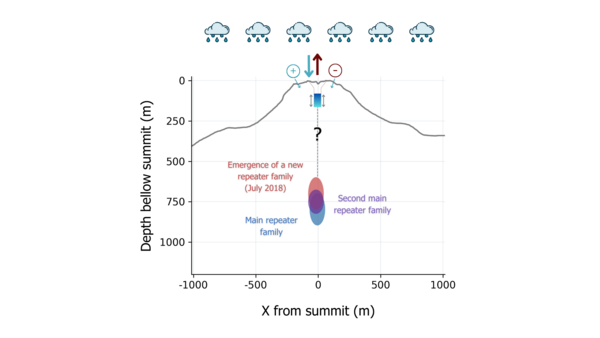Identification and modeling of forcings influencing seasonal
microseismicity at La Soufrière in Guadeloupe: combining GNSS and
hydrological data with M-SSA
Volcano-Tectonic (VT) seismicity is commonly recorded prior to magmatic
eruptions but not always prior phreatic or hydrothermal eruptions.
Understanding the shallow seismicity dynamics in hydrothermal systems is
crucial to survey potential phreatic eruptions. La Soufrière de
Guadeloupe volcano, with its seismo-volcanic activity linked to an
active hydrothermal system, and dense monitoring network, offers an
opportunity to identify the physical processes modulating volcanic
seismicity.
Microseismicity at La Soufrière is mainly shallow, characterized by VT
repeaters occurring in swarms. It has been located under the Tarissan
acid lake (TAS), along a narrow subvertical conduit at a depth of less
than 800 m below the summit. The Mlv 4.1 April 2018 earthquake caused an
increase dynamic stresses variations on the dome, resulting in an
increase in seismicity and the emergence of a shallower repeater. This
damage is interpreted as the vertical extension of a pre-existing
fracture, where microseismicity is localized. The system appears to
become more responsive to periodic external forcing superimposed on
internal forcing. A statistical analysis reveals periodicities in
microseismicity, with a prominent peak in activity during
October-November and a secondary peak of lower amplitude in April
(Pantobe et al., 2024).
Given the hydrological cycle in Guadeloupe and the proximity of
seismicity to the TAS, we are investigating a link with hydrology and
deformation (GNSS). We use Multichannel Singular Spectrum Analysis
(M-SSA, Ghil et al., 2002) to unravel spatial and temporal correlations
between these datasets. In the result, we detect a common yearly
periodicity between seismicity peaks, TAS level and vertical strain.
Finally, to explain the link between microseismicity and hydrology, we
model variations in stresses related to the hydrological cycle, notably
poroelastic stresses, using the cubic model of Kuvshinov (2008), caused
by groundwater variations in La Soufrière de Guadeloupe shallow
aquifer. By carefully studying the elastic parameters of the medium, we
calculate the variation in Coulomb stress in the conduit where
seismicity is mainly located. The results suggest that the rate of
seismicity appears to be in phase with variations in Coulomb stress.
Laëtitia Pantobe, IPGP
Top NewsPast event
Séminaire
13
June 2024
13h
14h
Salle du Conseil

